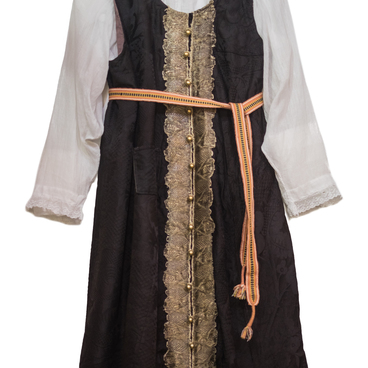This rectangular tray with metal sides and a Dutchware bottom was made in the early 20th century. It comes with a set of fruit knives, which are attached to special plates on the sides, near the handles. Each plate holds six knives. The bottom of the tray is painted with iris flowers and green leaves. The sides are decorated with openwork metal carving. The bottom of the sides forms the tray frame, made of arched curved strips, to which the bottom is attached. There are also four teardrop-shaped legs at the bottom of the tray.
Tray with fruit knives
Creation period
Early 20th century
Dimensions
Base length: 35 cm, bottom insert: 25.5 × 15.4 cm, knives – length: 15.5 cm, width: 1.8 cm
Technique
Stamping, casting, painting
Collection
6
Open in app#1
Tray with fruit knives
#8
#11
The fruit knives with ceramic handles have dark yellow blades, rectangular near the handles and dagger-shaped at the ends. The cutting edges are sharpened on both sides. The handles of the knives are white, decorated with blue floral and geometric patterns, slightly wider and rounded towards the ends. The fastening of the blades in the handles is reinforced with metal holders.
#9
Tray with fruit knives. Early 20th century.
#14
In Russia, Dutchware production developed simultaneously with porcelain production, and even lagging behind it. It began in the 18th century, and by the first quarter of the 19th century, a large industry for that time had developed. First, Dutchware factories appeared in the central part of Russia, and then in the Urals. The first such enterprises were rather imperfect both in production technologies and in the level of equipment. Their products were rather crude and primitive, and besides, they were entirely based on manual labor.
#15
The flourishing of Russian Dutchware began in the first half of the 19th century, when the Dutchware industry in the country was on the rise: new factories were opened, product quality improved. By that time, expensive hand-painting began to be replaced by less expensive printing. This made it possible to produce more products in a short time and make them more affordable. Russian Dutchware, unlike porcelain, was never regarded as a luxury item, but was used in everyday life.
#16
In the second half of the 19th century, many small porcelain and Dutchware enterprises went bankrupt. The remaining factories were combined in the hands of large monopolists. One of them was Matvey Kuznetsov, who, in 1887, founded M. S. Kuznetsov’s Partnership for Production of Porcelain and Dutchware Items.
#17
State Autonomous Cultural Institution of the Sverdlovsk Region "Nevyansk State Historical and Architectural Museum"
read morehide
00:00
00:00
1x
Tray with fruit knives
Creation period
Early 20th century
Dimensions
Base length: 35 cm, bottom insert: 25.5 × 15.4 cm, knives – length: 15.5 cm, width: 1.8 cm
Technique
Stamping, casting, painting
Collection
6
Open in app
Share

